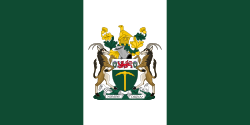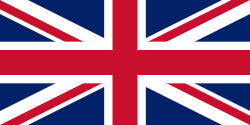 |
|---|
Wikimedia Commons has media related to Flags of Zimbabwe .
This is a list of flags used in Zimbabwe (Africa) from 1980 to the present date. For flags before April 1980 see List of Rhodesian flags .
 |
|---|
This is a list of flags used in Zimbabwe (Africa) from 1980 to the present date. For flags before April 1980 see List of Rhodesian flags .
| Flag | Date | Use | Description |
|---|---|---|---|
 | 1980 – | National Flag of Zimbabwe | Seven equal horizontal stripes of green, yellow, red, black, red, yellow and green with a white triangle with its base at the hoist, fimbriated in black, containing a red five-pointed star on which is superimposed a representation of the Zimbabwe Bird in yellow. |
| Flag | Date | Use | Description |
|---|---|---|---|
 | 1987– | Flag of the president of Zimbabwe | A green background with the Zimbabwean coat of arms in the centre, with a white triangle with its base at the hoist containing a red five-pointed star on which is superimposed a representation of the Zimbabwe Bird in yellow. In the top right and bottom right hand corners there are horizontal stripes of yellow, red, black, red and yellow. |
| Flag | Date | Use | Description |
|---|---|---|---|
 | 1980 – | Flag of the Zimbabwe National Army | Zimbabwe National Army Flag has a red background with the Zimbabwe National Army emblem in the centre. |
 | 1980 – | Flag of the Air Force of Zimbabwe | Zimbabwe Air Force Flag has a light blue background with the Zimbabwe national flag in the canton and the emblem of the Zimbabwe Air Force in the fly. |
 | 1980 – | Flag of the Zimbabwe Defence Forces | Zimbabwe Defence Forces Flag is divided vertically into red and blue with the emblem of the Zimbabwe Defence Forces in the centre. |
| Flag | Date | Use | Description |
|---|---|---|---|
 | Circa mid-1970s - | Flag of the Zimbabwe African National Union-Patriotic Front (ZANU PF) | The ZANU-PF flag comprises concentric rectangular stripes of green, yellow, red and black. |
 | 1999 – | Flag of the Movement for Democratic Change (MDC) | The MDC party flag has four equal horizontal stripes of green, yellow, red and black with the party open-hand emblem in the centre and the party acronym in white on the black stripe. |
 | Flag of the Liberal Democrats | ||
 | Flag of the Zimbabwe African People's Union (ZAPU) | ||
 | Flag of the Mthwakazi Republic Party |
| Flag | Date | Use | Description |
|---|---|---|---|
 | Flag of Bulawayo | The coat of arms of Bulawayo on a blue background. | |
| Flag of Victoria Falls | Victoria Falls Coat of Arms in the centre | ||
 | 1986 – | Flag of Chitungwiza | The flag of Chitungwiza consists of orange-white-orange horizontal stripes with the city’s coat of arms at the centre. |
| Flag of Kariba | Kariba Coat of Arms in the centre | ||
| Flag of Chinhoyi | Chinhoyi Coat of Arms in the centre | ||
| Flag of Kadoma | Kadoma Coat of Arms in the centre | ||
| Flag of Kwekwe | Kwekwe Coat of Arms in the centre | ||
| Flag of Plumtree | Plumtree Coat of Arms in the centre | ||
| Flag of Gokwe | Gokwe Coat of Arms in the centre | ||
 | 1986 – | Flag of Gweru | Tricolore flag with Gweru Coat of Arms on white stripe. |
 | 1982 – | Flag of Harare | Flag of Harare featuring the Zimbabwe bird. |
 | Flag of Marondera | Marondera Coat of Arms on a green background. | |
| Flag of Hwange | Hwange Coat of Arms in the centre | ||
 | 1985 – | Flag of Mutare | Mutare Coat of Arms on a white background |
| Flag of Masvingo | Masvingo Coat of Arms in the centre |
| Flag | Date | Use | Description |
|---|---|---|---|
 | 1890–1923 | Flag of the British South Africa Company (BSAC) | The BSAC flag was a Union Jack defaced in the centre of a white roundel with the BSAC logo. |
 | 1923–1953 | Flag of Southern Rhodesia | A defaced blue ensign with the shield from the Southern Rhodesian Coat of Arms in the fly. |
 | 1953–1963 | Flag of the Central African Federation | A defaced blue ensign with the shield from the federal Coat of Arms, showing the amalgamation of Northern Rhodesia, Southern Rhodesia, and Nyasaland, in the fly |
 | 1964–1968 | Flag of Rhodesia | A Sky-Blue ensign with the shield from the Rhodesian Coat of Arms in the fly. |
 | 1968–1979 | Flag of Rhodesia | A Green-White-Green vertical tricolor with the full Coat of Arms of Rhodesia in the centre of the white stripe (not international recognize). |
 | 1979 | Flag of Zimbabwe Rhodesia | A Red-White-Green horizontal tricolor with white-fimbriated black vertical stripe at the hoist containing a representation of the Zimbabwe Bird in the canton in yellow. |
 | 1979-1980 | Flag of Southern Rhodesia | The Flag of the United Kingdom was used. |
 | 1981–1986 | Flag of the president of Zimbabwe | The Flag of Zimbabwe defaced with a white square bearing the Zimbabwean Coat of Arms. |
| Flag | Date | Use | Description |
|---|---|---|---|
 | Matabele people |